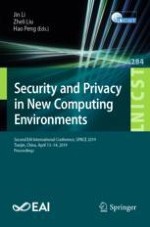2019 | Book
Security and Privacy in New Computing Environments
Second EAI International Conference, SPNCE 2019, Tianjin, China, April 13–14, 2019, Proceedings
Editors: Dr. Jin Li, Zheli Liu, Hao Peng
Publisher: Springer International Publishing
Book Series : Lecture Notes of the Institute for Computer Sciences, Social Informatics and Telecommunications Engineering
